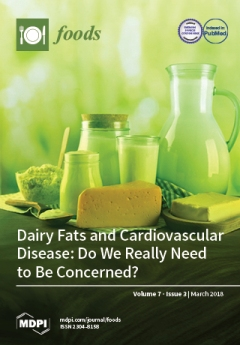The objectives of the present study were: (a) to evaluate the aroma evolution of raw lamb packaged in multi-layer coating film and stored at 4 ± 1 °C, with respect to storage time and (b) to investigate whether specific aldehyde ratios could serve as markers of lamb meat freshness and degree of oxidation. Volatile compounds were determined using headspace solid phase microextraction coupled to gas chromatography/mass spectrometry. Results showed that the most dominant volatiles were 2,2,4,6,6-pentamethyl-heptane, hexanal, 1-octen-3-ol, 1-hexanol, carbon disulfide and
p-cymene. Volatile compound content was increased during storage time. However, statistically significant differences were recorded only for hexanal, heptanal, and nonanal (
p < 0.05). Additionally, the evolution of aldehydes during storage recorded a positive Pearson’s correlation (
r) (
p < 0.05), whereas hexanal to nonanal, heptanal to nonanal, octanal to nonanal ratios, along with the sum of aldehydes to nonanal ratio, were positively correlated (
r = 0.83–1.00) with the degree of oxidation (mg malonic dialdehyde per kg of lamb meat). A perfect Pearson’s correlation (
r = 1) was obtained for the ratio hexanal to nonanal. Therefore, this ratio is proposed as an indicator of lamb meat freshness and overall quality.
Full article






